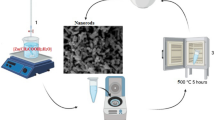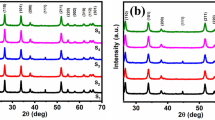Abstract
ZnO nanotubes were produced via co-precipitation, and the effects of Co and Gd on their structural, magnetic, and dielectric properties were reported. Utilizing Co and Gd into ZnO decreased the crystallization rate while maintaining the optimal symmetry, as shown by the results. The morphology of the synthesized nanotubes was shown to be unaffected by the Co and Gd dopants, as determined by transmission electron microscopy and scanning electron microscopy analyses. It was also shown that the dielectric constant and dielectric loss values increased with decreasing frequency and concentration of the Gd co-dopant. Doping was discovered to have an inverse relationship with the dielectric constant and the ac electrical conductivity reaction. Finally, ferromagnetic characteristics were observed in Co- and Gd-co-doped ZnO nanotubes at 300 K. The ferromagnetic reaction improved as Co and Gd co-doping was raised to 4%. Since then, increasing the Gd co-doping has resulted in a reduced ferromagnetic reaction. Electrical conductivity for the same material (Zn0.92Co0.04Gd0.04O nanotubes) was shown to be superior to pure and less in Co–Gd-co-doped ZnO. Magnetic impurities doped into the ZnO side often account for its high ferromagnetism. Given the properties of these nanotubes, they have potential applications in spintronics.






Similar content being viewed by others
Data availability
On reasonable request, the corresponding author will make available the datasets used and/or created during this investigation. The experimental work and language of the manuscript are also unique. There was no evidence of plagiarism in the submitted manuscript. If the reviewer insists on seeing the evidence, we would gladly deliver it to them in a plagiarized form.
References
Y. Hao et al., Novel magnetic behavior of Mn-doped ZnO hierarchical hollow spheres. J. Nanopart. Res. 14(1), 1–9 (2012)
G.A. Prinz, Magnetoelectron. Sci. 282(5394), 1660–1663 (1998)
R. Khan et al., Structure and magnetic properties of (Co, Ce) co-doped ZnO-based diluted magnetic semiconductor nanoparticles. J. Mater. Sci.: Mater. Electron. 32(19), 24394–24400 (2021)
P. Li et al., Structural and optical properties of co-doped ZnO nanocrystallites prepared by a one-step solution route. J. Lumin. 132(1), 220–225 (2012)
R. Khan et al., Effect of Sn-doping on the structural, optical, dielectric and magnetic properties of ZnO nanoparticles for spintronics applications. J. Mater. Sci.: Mater. Electron. 32(16), 21631–21642 (2021)
X. Wang et al., Properties of Ni doped and Ni–Ga co-doped ZnO thin films prepared by pulsed laser deposition. J. Alloys Compd. 509(7), 3282–3285 (2011)
Y.-M. Hao et al., Structural, optical, and magnetic studies of manganese-doped zinc oxide hierarchical microspheres by self-assembly of nanoparticles. Nanoscale Res. Lett. 7(1), 1–9 (2012)
A. Stroppa, X. Duan, M. Peressi, Structural and magnetic properties of Mn-doped GaAs (110) surface. Mater. Sci. Eng.: B 126(2–3), 217–221 (2006)
Y. Chang et al., Synthesis, optical, and magnetic properties of diluted magnetic semiconductor zn 1–x mn x O nanowires via vapor phase growth. Appl. Phys. Lett. 83(19), 4020–4022 (2003)
X. Lv et al., Coexisting multi-phase and relaxation behavior in high-performance lead-free piezoceramics. Acta Mater. 238, 118221 (2022)
J. Fu et al., Synthesis and structural characterization of ZnO doped with Co. J. Alloys Compd. 558, 212–221 (2013)
X. Xu, C. Cao, Structure and ferromagnetic properties of co-doped ZnO powders. J. Magn. Magn. Mater. 321(14), 2216–2219 (2009)
N.G. Szwacki, J. Majewski, T. Dietl, Aggregation and magnetism of Cr, Mn, and Fe cations in GaN. Phys. Rev. B 83(18), 184417 (2011)
Z. Lu et al., Carrier-mediated ferromagnetism in single crystalline (Co, Ga)-codoped ZnO films. Appl. Phys. Lett. 94(15), 152507 (2009)
L. Sun et al., Room-temperature ferromagnetism and in-plane magnetic anisotropy characteristics of nonpolar GaN: mn films. Appl. Surf. Sci. 255(16), 7451–7454 (2009)
G. Husnain, F. Tao, S.-D. Yao, Structural and magnetic properties of Co+ implanted n-GaN dilute magnetic semiconductors. Phys. B: Condens. Matter 405(9), 2340–2343 (2010)
Z. Cui et al., Fabrication of a g-C3N4/MoS2 photocatalyst for enhanced RhB degradation. Phys. E: Low-dimens. Syst. Nanostruct. 144, 115361 (2022)
Z. Cui et al., Adsorption of metal atoms on MoSi2N4 monolayer: a first principles study. Mater. Sci. Semiconduct. Process. 152, 107072 (2022)
Z. Cui et al., Optoelectronic and magnetic properties of transition metals adsorbed Pd2Se3 monolayer. Micro Nanostruct. 167, 207260 (2022)
L. Zhang, Z. Cui, Electronic, magnetic, and optical performances of non-metals doped silicon carbide. Front. Chem. 10(2022)
S. Fabbiyola et al., Synthesis of co-doped ZnO nanoparticles via co-precipitation: structural, optical and magnetic properties. Powder Technol. 286, 757–765 (2015)
H. Hao, M. Qin, P. Li, Structural, optical, and magnetic properties of co-doped ZnO nanorods fabricated by a facile solution route. J. Alloys Compd. 515, 143–148 (2012)
T. Oshio et al., Effect of Mn doping on the electric and dielectric properties of ZnO epitaxial films. J. Appl. Phys. 103(9), 093717 (2008)
R. Khan, M.-U. Rahman, S. Fashu, Effect of annealing temperature on the dielectric and magnetic response of (Co, Zn) co-doped SnO2 nanoparticles. J. Mater. Sci.: Mater. Electron. 28(3), 2673–2679 (2017)
Zulfiqar et al., Oxygen vacancies induced room temperature ferromagnetism and enhanced dielectric properties in Co and Mn co-doped ZnO nanoparticles. J. Mater. Sci.: Mater. Electron. 32, 9463–9474 (2021)
R. Khan et al., The structural and dilute magnetic properties of (Co, Li) co-doped-ZnO semiconductor nanoparticles. MRS Commun. 12(2), 154–159 (2022)
R. Khan et al., Room temperature dilute magnetic semiconductor response in (Gd, Co) co-doped ZnO for efficient spintronics applications. RSC Adv. 12(55), 36126–36137 (2022)
G. Vijayaprasath et al., Optical and magnetic studies on Gd doped ZnO nanoparticles synthesized by co-precipitation method. J. Lumin. 178, 375–383 (2016)
R. Khan, Y. Zaman, Effect of annealing on structural, dielectric, transport and magnetic properties of (Zn, Co) co-doped SnO2 nanoparticles. J. Mater. Sci.: Mater. Electron. 27(4), 4003–4010 (2016)
R. Khan, S. Fashu, M.-U. Rahman, Effects of Ni co-doping concentrations on dielectric and magnetic properties of (Co, Ni) co-doped SnO2 nanoparticles. J. Mater. Sci.: Mater. Electron. 27(8), 7725–7730 (2016)
R. Khan, S. Fashu, Effect of annealing on Ni-doped ZnO nanoparticles synthesized by the co-precipitation method. J. Mater. Sci.: Mater. Electron. 28(14), 10122–10130 (2017)
C. Cong et al., Effects of temperature on the ferromagnetism of Mn-doped ZnO nanoparticles and Mn-related raman vibration. Nanotechnology 17(5), 1520 (2006)
R. Khan, S. Fashu, Y. Zaman, Magnetic and dielectric properties of (Co, Zn) co-doped SnO2 diluted magnetic semiconducting nanoparticles. J. Mater. Sci.: Mater. Electron. 27(6), 5960–5966 (2016)
R. Khan et al., Structure and magnetic properties of (Co, Mn) co-doped ZnO diluted magnetic semiconductor nanoparticles. J. Mater. Sci.: Mater. Electron. 29(1), 32–37 (2018)
S. Biswas et al., Selective enhancement in phonon scattering leads to a high thermoelectric figure-of-merit in graphene oxide-encapsulated ZnO nanocomposites. ACS Appl. Mater. Interfac. 13(20), 23771–23786 (2021)
X. Lv et al., Coupling effects of the A-site ions on high-performance potassium sodium niobate ceramics. J. Mater. Sci. Technol. 130, 198–207 (2022)
R. Khan et al., Effect of air annealing on the structure, dielectric and magnetic properties of (Co, Ni) co-doped SnO2 nanoparticles. J. Mater. Sci.: Mater. Electron. 27(10), 10532–10540 (2016)
S.-P. Szu, C.-Y. Lin, AC impedance studies of copper doped silica glass. Mater. Chem. Phys. 82(2), 295–300 (2003)
F. Gu et al., Photoluminescence properties of SnO2 nanoparticles synthesized by sol – gel method. J. Phys. Chem. B 108(24), 8119–8123 (2004)
P.S. Neelakanta, Handbook of electromagnetic materials: monolithic and composite versions and their applications (CRC Press, Boca Raton, 1995)
M.S. Samuel et al., Dielectric behavior and transport properties of ZnO nanorods. Phys. B: Condens. Matter. 406(15–16), 3023–3029 (2011)
R. Khan, S. Fashu, Structural, dielectric and magnetic properties of (Al, Ni) co-doped ZnO nanoparticles. J. Mater. Sci.: Mater. Electron. 28, 4333–4339 (2017)
O. Pakma et al., Influence of frequency and bias voltage on dielectric properties and electrical conductivity of Al/TiO2/p-Si/p+ (MOS) structures. J. Phys. D 41(21), 215103 (2008)
R. Elilarassi, G. Chandrasekaran, Synthesis and characterization of ball milled Fe-doped ZnO diluted magnetic semiconductor. Optoelectron. Lett. 8(2), 109–112 (2012)
Y. Lin et al., Fe-doped ZnO magnetic semiconductor by mechanical alloying. J. Alloys Compd. 436(1–2), 30–33 (2007)
S. Yin et al., Absence of ferromagnetism in bulk polycrystalline Zn 0.9 Co 0.1 O. Phys. Rev. B 73(22), 224408 (2006)
Acknowledgements
Muhammad Adil Mahmood, Khaled Althubeiti, Sherzod Sh. Abdullaev, Nasir Rahman, Mohammad Sohail, Shahid Iqbal, Kashif Safeen, Akif Safeen, Aurangzeb Khan, and Rajwali Khan equally contributed to this article and all the authors acknowledge the financial support from Taif University for sponsorship and support. We also acknowledge the support and guidance provided by Taif University.
Author information
Authors and Affiliations
Contributions
This paper was written and revised collaboratively by MAM, KA, and SSA. NR, MS, SI, KS, AS, AK, and RK created the idea and submitted the paper.
Corresponding author
Ethics declarations
Conflict of interest
The authors declare that they have no known competing financial interests or personal relationships that could have influenced the work reported in this paper.
Additional information
Publisher’s Note
Springer Nature remains neutral with regard to jurisdictional claims in published maps and institutional affiliations.
Rights and permissions
Springer Nature or its licensor (e.g. a society or other partner) holds exclusive rights to this article under a publishing agreement with the author(s) or other rightsholder(s); author self-archiving of the accepted manuscript version of this article is solely governed by the terms of such publishing agreement and applicable law.
About this article
Cite this article
Mahmood, M.A., Althubeiti, K., Abdullaev, S.S. et al. Diluted magnetic semiconductor behavior in Co- and Gd-co-doped ZnO nanotubes for spintronic applications. J Mater Sci: Mater Electron 34, 1784 (2023). https://doi.org/10.1007/s10854-023-11181-4
Received:
Accepted:
Published:
DOI: https://doi.org/10.1007/s10854-023-11181-4




